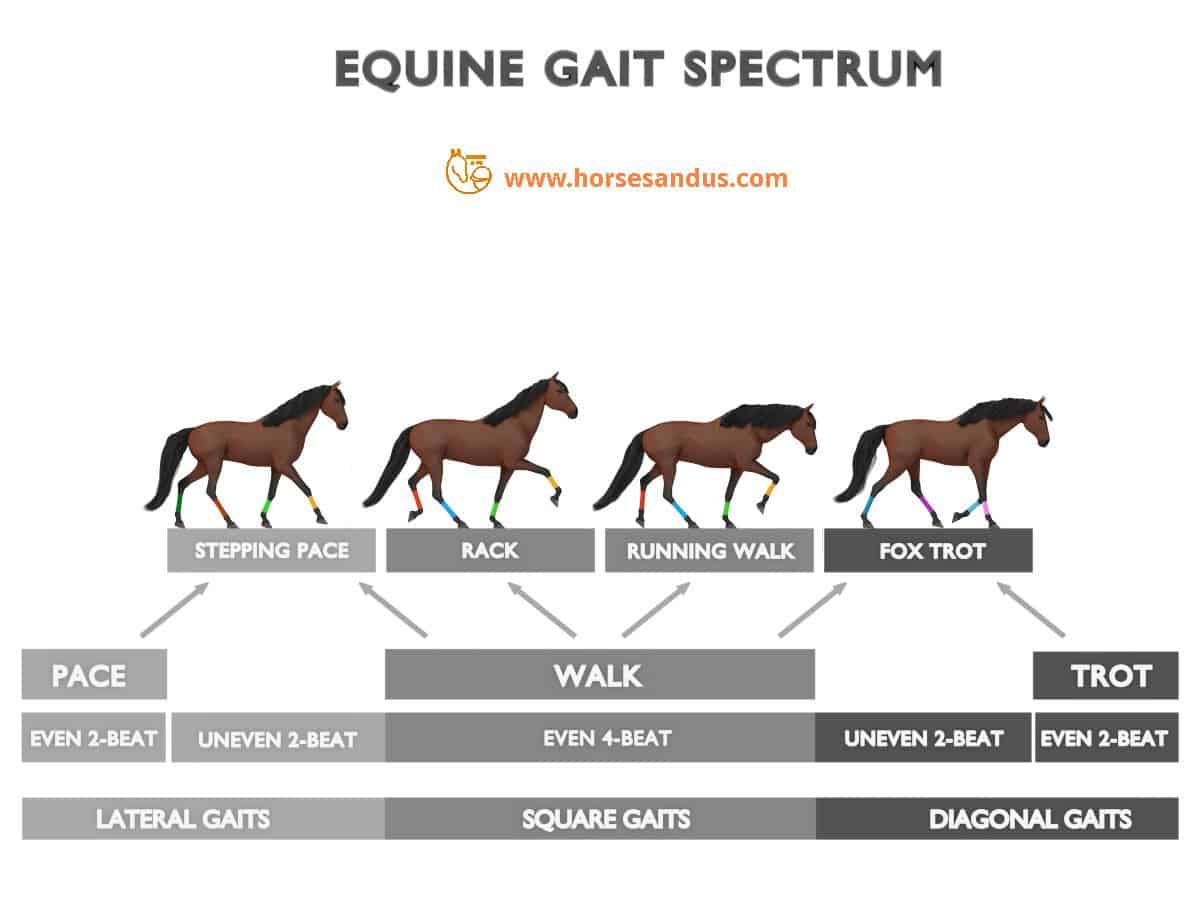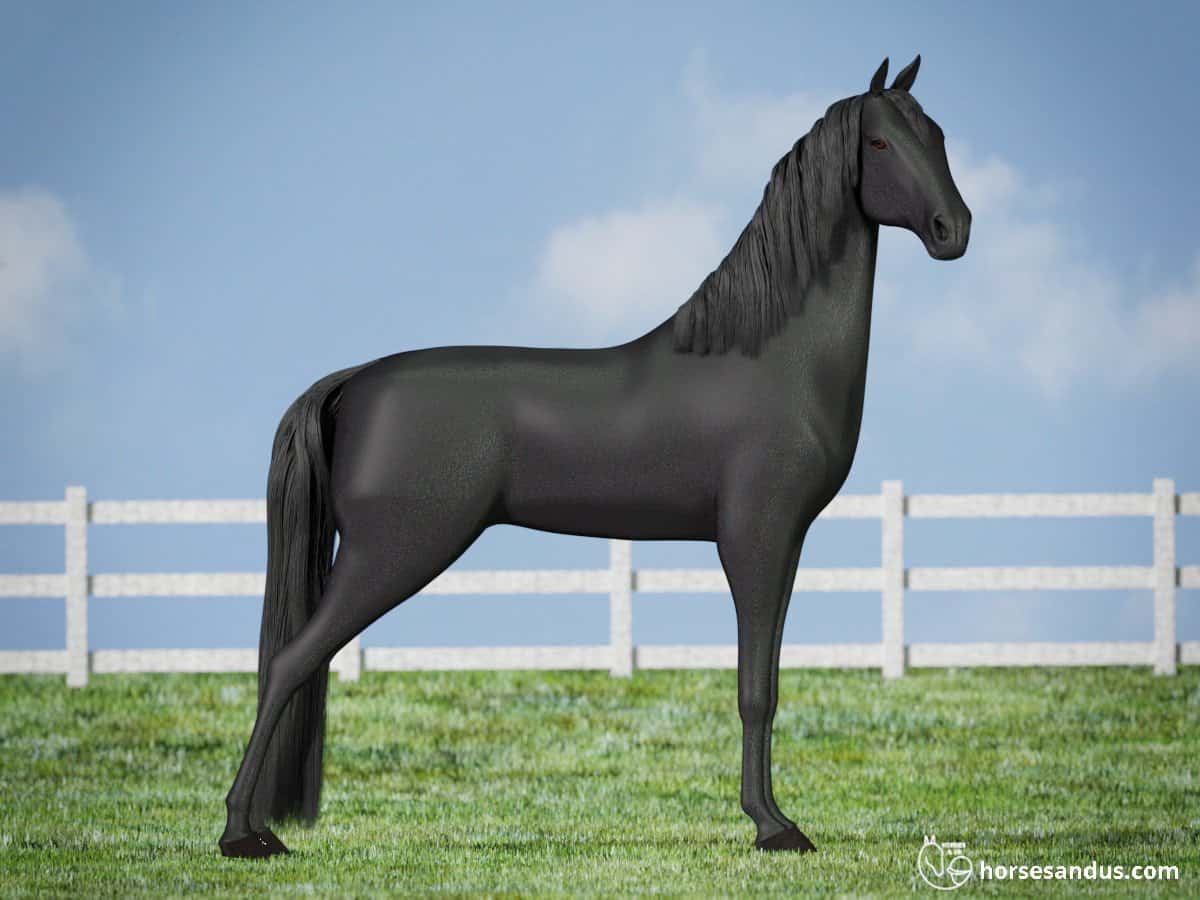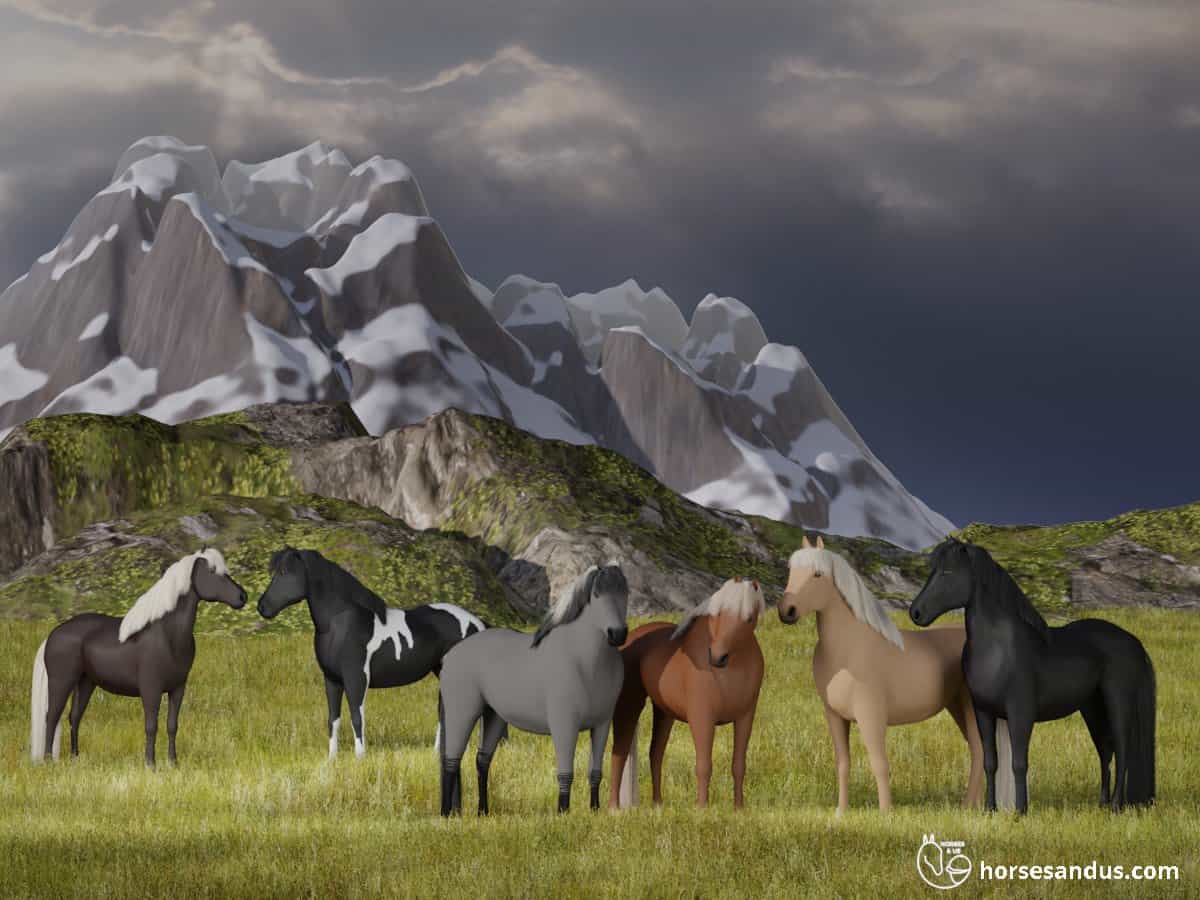Braiding is a long-time tradition dating back hundreds of years and was initially done for practical reasons. Later it developed into a more aesthetic function, to enhance the look of the horse’s neck and as a status symbol for the horse owner. In equestrian competitions, it demonstrates your interest and respect for the horse, the sport, and the judges.
There are many different horse mane braiding styles, from the very simple to the more elaborate. The different styles will depend on the occasion, the equine discipline, and even the horse breed.
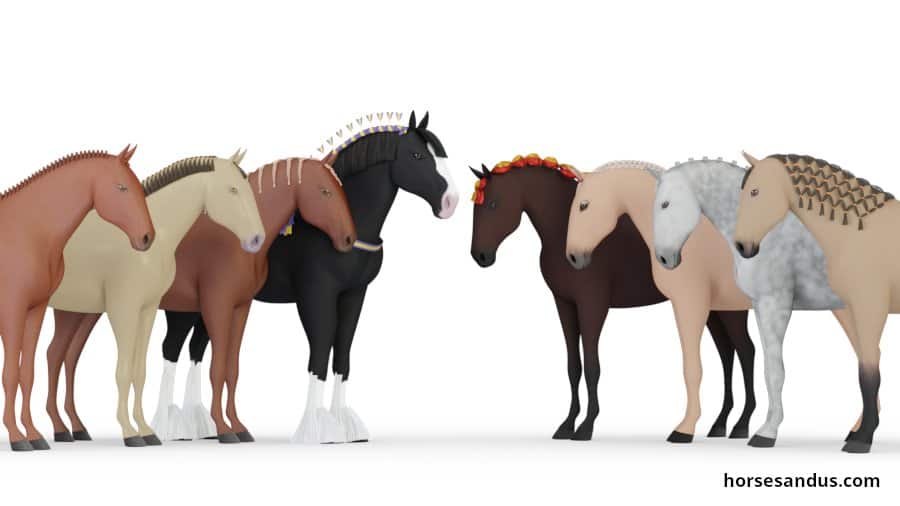
The most popular mane braiding styles are:
- Straight Braids
- Running Braid
- Button Braids
- Hunter Braids
- Continental Braid
- Western Mane Banding
The reasons for braiding a horse’s mane are the following:
- Functional – Braiding a horse’s mane and tail has been done for hundreds of years to prevent the mane and tail from getting tangled up in the riding equipment, farming equipment, and military weapons. This was specially needed for long manes.
- Maintenance – A Braided mane and tail can preserve the hairs’ health by preventing them from getting tangled and broken.
- Aesthetic – Today, one of the main reasons for braiding is to enhance the horse’s appearance. This is a way for them to stand out in equestrian shows and competitions. In competitions like dressage, the horse must have a “polished” look to impress the judges.
- Pleasure – Braiding your horse’s mane can be a fun and relaxing activity, which increases the bond with your horse.
There are many braiding styles, and with the right braiding tools, you can try them on your horse. This article will mention the most popular ones.
Most mane braiding styles are based on two basic types:
- Multiple Straight Braids, ideal for short manes.
- Some variation of the Running Braid, used for long manes.
1. Straight Braids
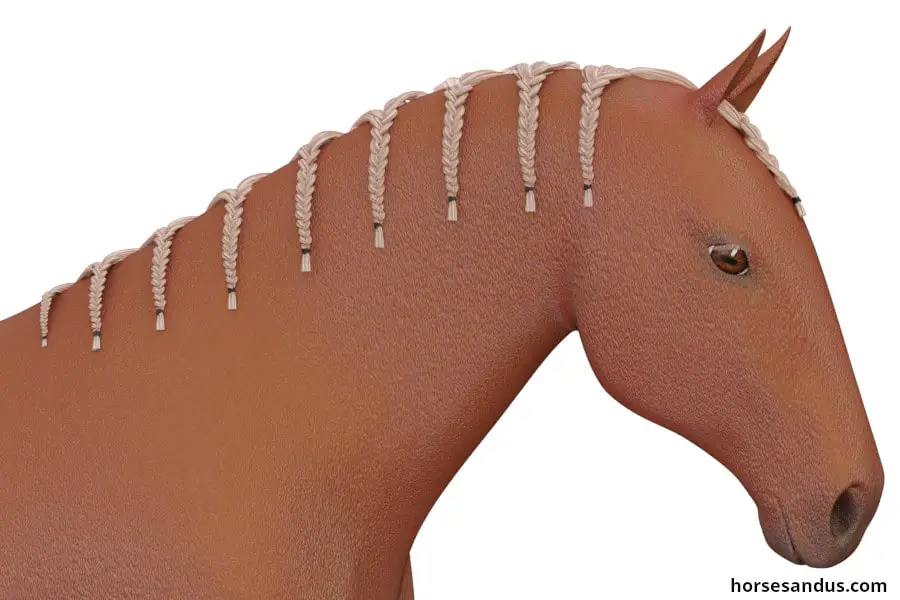
Straight braids are the most basic braid style and are made by interlacing 3 strands of hair for each braid. They are used for the following 3 purposes:
- 1 – For maintenance of the mane
Unattended manes tend to get tangled due to the natural grease, dirt, and rubbing. Horses that are outside have additionally in their environment, the weather elements like rain and wind that cause the manes to get tangled.
So to keep them clean, they need to be combed frequently. However, too much combing and brushing can cause the hairs to break and split.
So the best option for clean and healthy manes is to braid them.
The quickest and easiest option for maintaining a long mane is to create a series of straight braids.
Make sure they are not too tight so that the horse feels comfortable. Take special care near the withers keeping them loose enough to allow the horse to lower the head without pulling the hairs. Rebraid every 10 to 15 days to avoid matting.
- 2 – To train the mane to fall to one side
Straight braids are also used to train the mane to stay on one side of the neck.
This can be useful when parts of the mane fall to either side or if you want to force the mane to be specifically on one of the sides due to the tradition of a particular breed or to the rules of an equestrian discipline.
- 3 – As a foundation for more elaborate braiding styles
The straight braids are used as a basis for other horse mane braiding styles such as hunter braids or button braids.
2. Running Braid
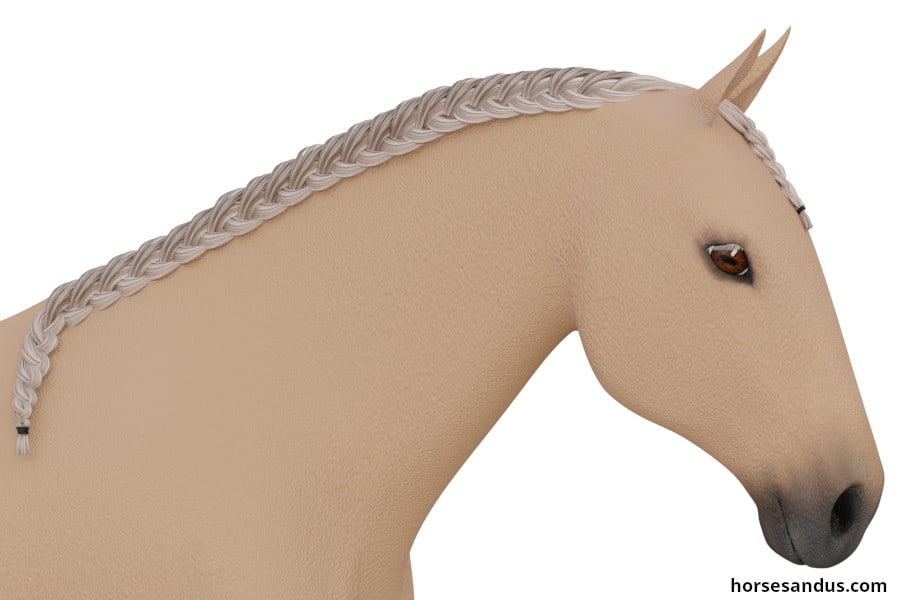
A running braid is when three different strands of hair are used to knead the braid, just like a straight braid. However, in every single turn, a few additional strands will be added to the braid.
The Running braid goes along the horse’s neck. It can be braided tightly along the crest or alongside the neck, usually with a gradual fall as it comes closer to the withers.
This style of braid is usually done on horses that have long manes. When the manes are very thick, two running braids are normally braided, one on each side of the neck.
This style of mane shows off the curve of the horse’s neck.
It is normally used for the 2 following reasons:
maintenance of a long mane
If the horse is outdoors, the straight braids are not the best option for maintenance of the mane because the braids can get caught in objects in the environment like twigs and fences. In this case, the running braid is the best solution.
Braid the mane against the crest, but not too tightly so that the horse can move his neck freely without pulling hairs out. This braid should be rebraided at least once a week.
long manes in equestrian disciplines that require braiding
In horses with long manes, the Running braid is a good solution for equestrian disciplines that require braiding, such as dressage.
Typically, dressage horses are braided with button braids, but it is not easy to braid them into buttons or knots when the manes are long.
So either the mane is shortened and thinned so that it can be braided into buttons or if it needs to be left long, then the other option is to use a running braid.
The 2 variants of the Running Braid
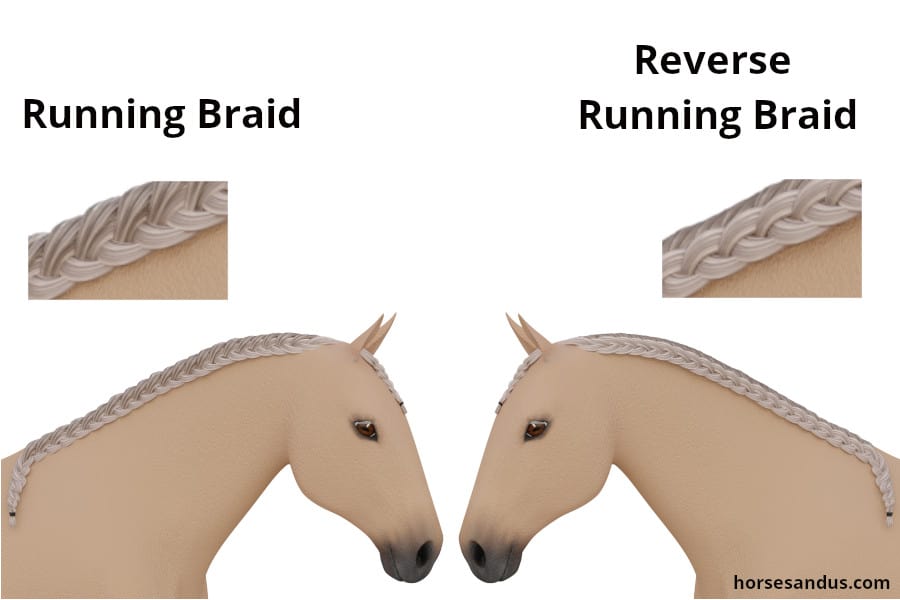
French braid – is a flat form of hair braiding. It is braided overhand, where additional strands of mane will be added to the top of the braid for every turn.
Dutch braid – is the reverse of the french braid and gives a 3D look to the mane. It is braided underhand, where additional strands of hair will be added to the braid’s underside for every turn. It is also called “inside-out.”
3. Button Braids
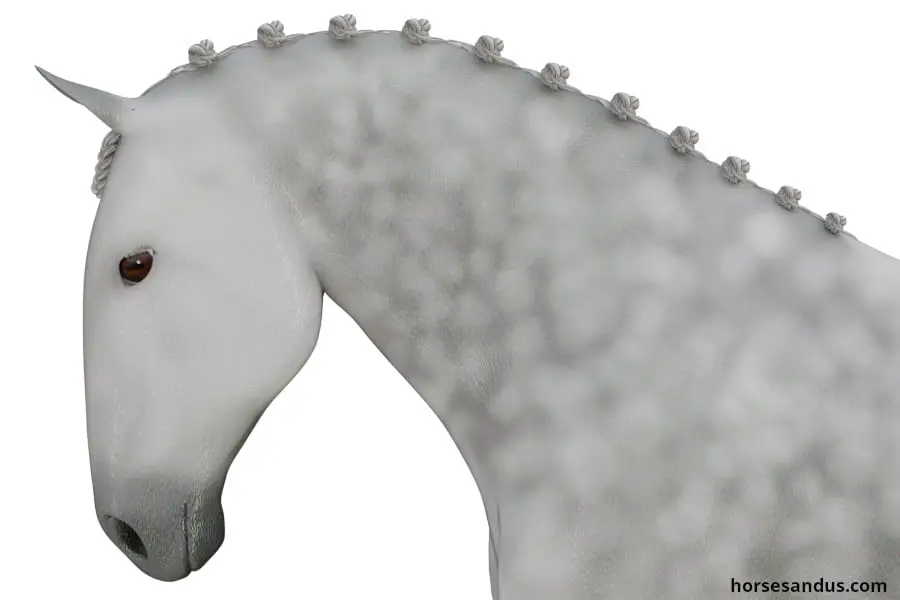
Button Braids also called rosette braids or dressage braids, are large rounded braids and limited in quantity. The number of braids should be odd and is usually between 11 and 17.
In mares and geldings, the forelock is braided in a french braid that is then tucked under. In stallions, the forelock is usually left unbraided.
These braids are commonly used for dressage competitions, and that is why they are also referred to as dressage braids. However, they are becoming increasingly popular in other disciplines like show jumping.
With these braids, the neck can be accentuated in different ways, depending on the quantity and the position of the braids.
More braids give the illusion of a longer neck, and braids positioned on top of the neck give the illusion of a higher crest.
The 2 variants of the Button Braids
- positioned on the side of the neck
- positioned on top of the neck.
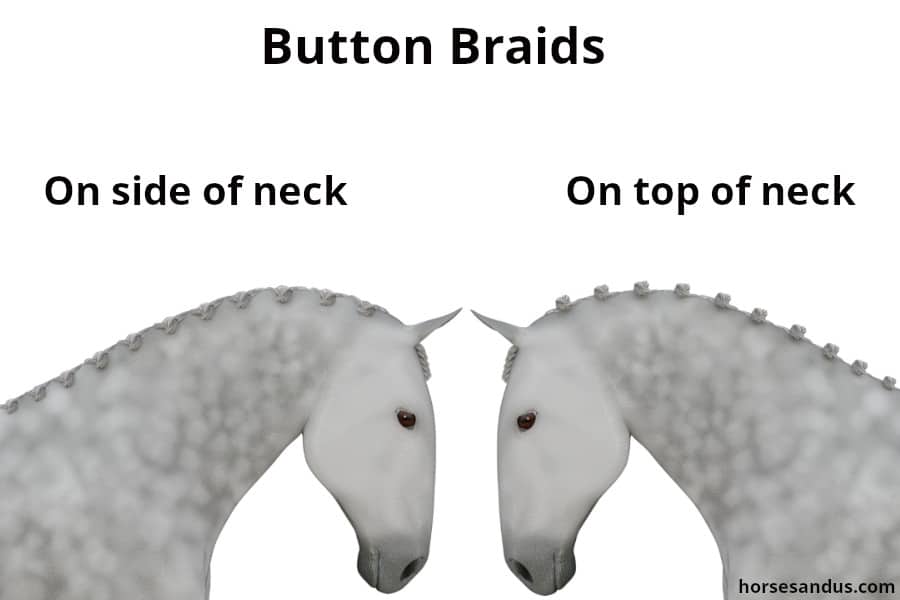
2. Hunter Braids
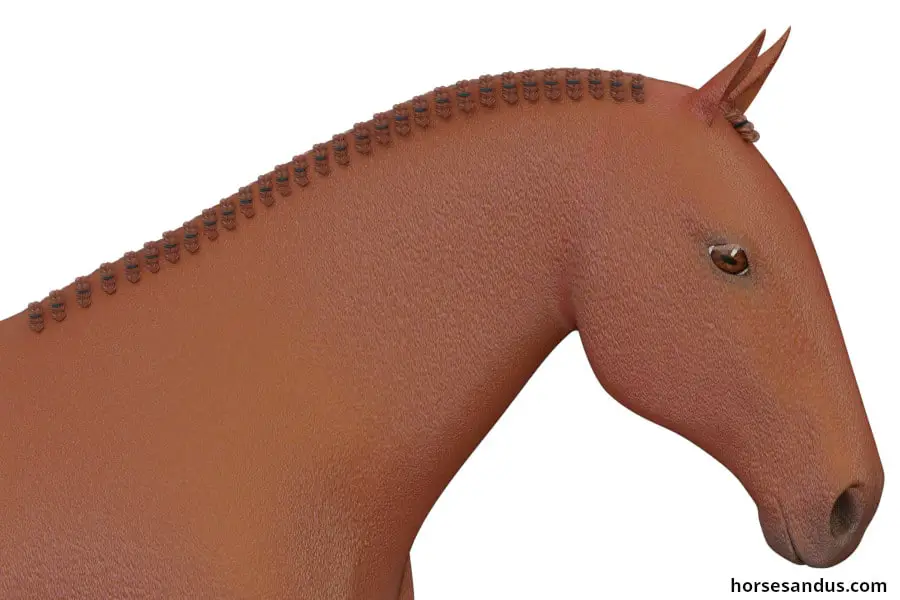
Hunter braids consist of many small and uniform braids and have the effect of accentuating the line of the horse’s neck. The uniformity and quantity of braids create a visual rhythm that draws your eyes along the neckline.
The quantity of braids varies between 30 and 40 depending on the thickness of the mane and the shape of the horse’s neck. The forelock is also braided with one braid.
To enhance the appearance of the horse´s neck, the “rule” is to have more braids for a shorter neck, which will give the illusion of a long neck, and fewer braids for a longer neck.
Besides adding elegance to the horse´s neck, these braids also have the practical purpose of keeping the mane out of the rider´s way while hunting.
The 2 variants of the Hunter Braids
- Flat braids – as the name suggests, lie flat on the neck and are the more traditional type.
- Knob braids – are a variation where the hunter braid is pushed up to create a “knob” at the top of the crest.
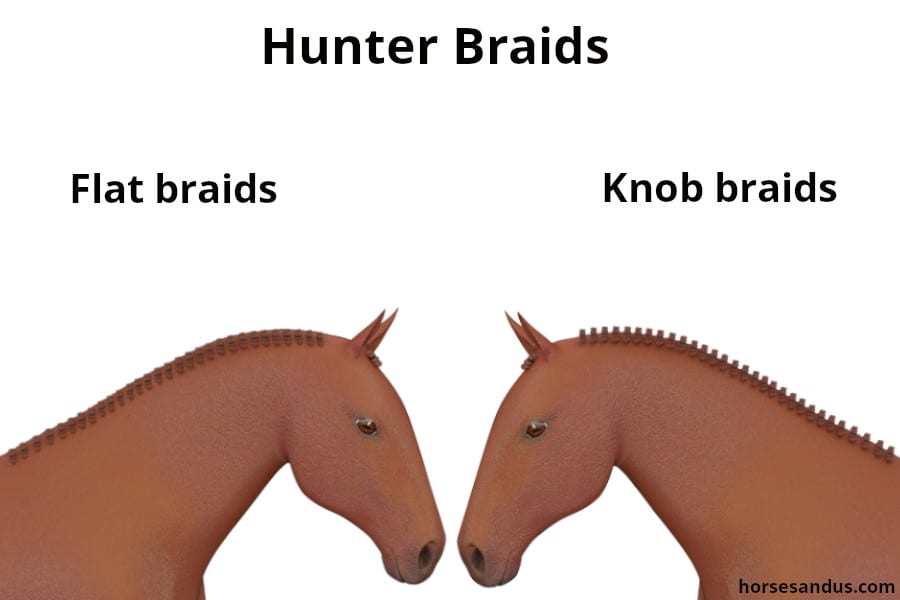
5. Continental Braid
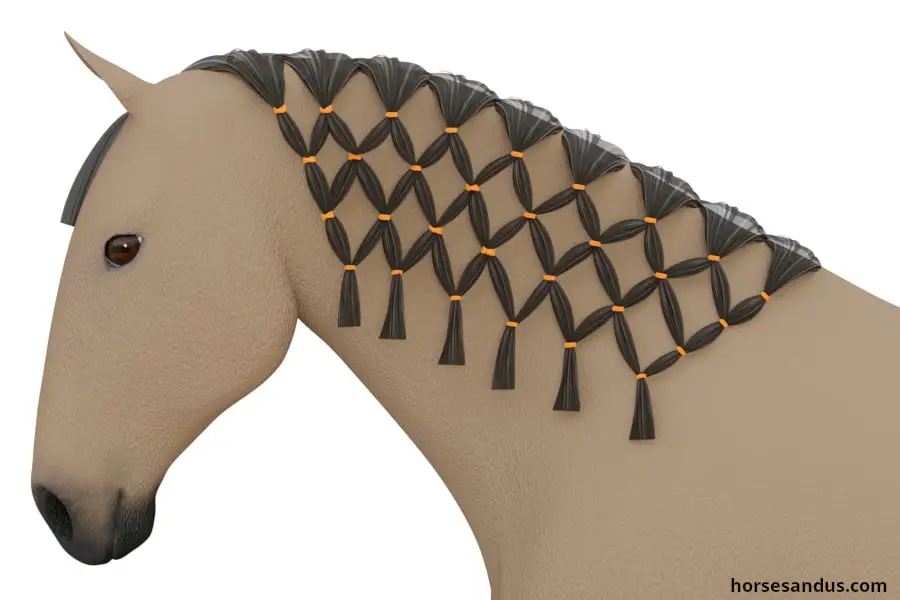
Continental Braid, also called Macrame braid or Diamond braid. It is a sort of a woven pattern that creates a net in the mane.
This is not actually a braid because it is made up of simple knots or using rubber bands, yarn, or even tape.
The braid is started by dividing the hair near the crest into sections and tying them with a rubber band or yarn. Next, each section is split into two, and each one of these is tied to the neighboring section. This process is repeated all the way down the length of the mane until it is complete.
This type of mane is best for long and thick manes and is very easy to create.
The continental braid is fun to do, and you can get creative by adding decorations like flowers or ribbons
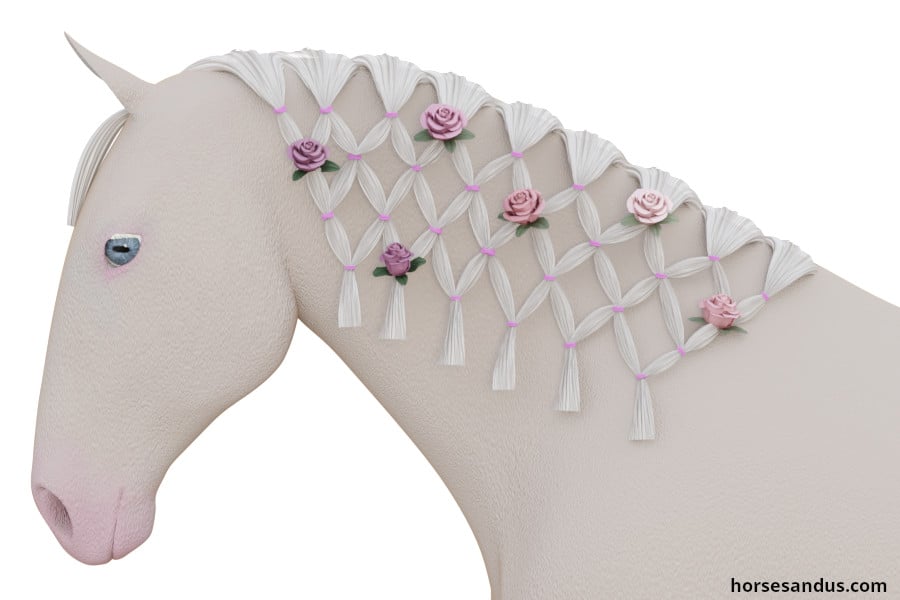
6. Western Mane Banding
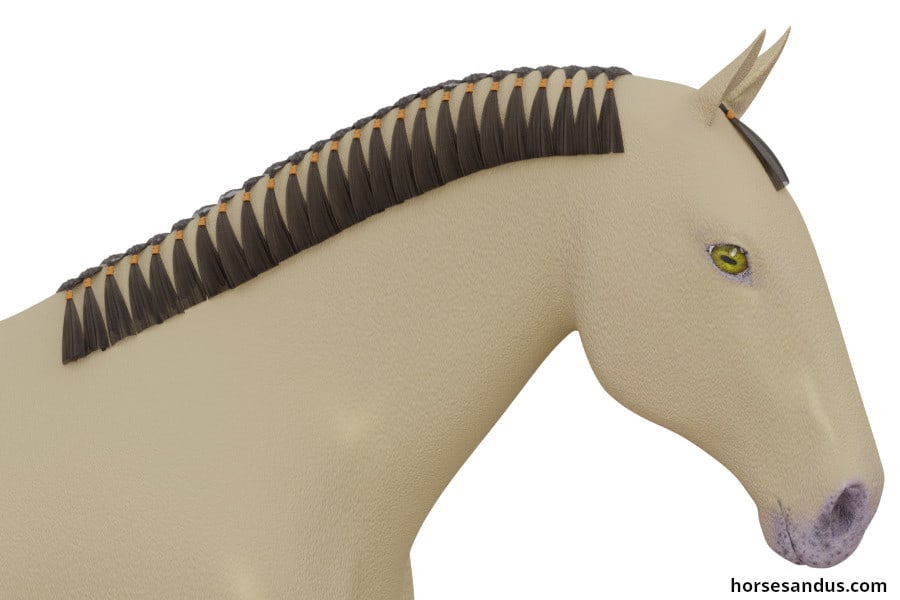
Western horses are usually not braided but banded instead.
In Western Mane Banding, the mane is divided into small sections and then tied with rubber bands at the top of each section near the crest.
Banding the mane allows it to lie flat on the horse’s neck, giving the illusion of a thinner neck. This enhances the appearance of the thick neck in most quarter horses.
This banding also serves the practical purpose of keeping the mane out of the rider´s way.
Traditional Decorative Braids
Some horse breeds have a tradition of braiding ribbons, wool, and some decorations into the manes.
The manes are decorated this way for shows and special events associated with the breed.
Next, we have two examples, one of a Baroque type (Lusitano horse ) and another of a Draft type (Shire horse).
Lusitano horse mane decoration
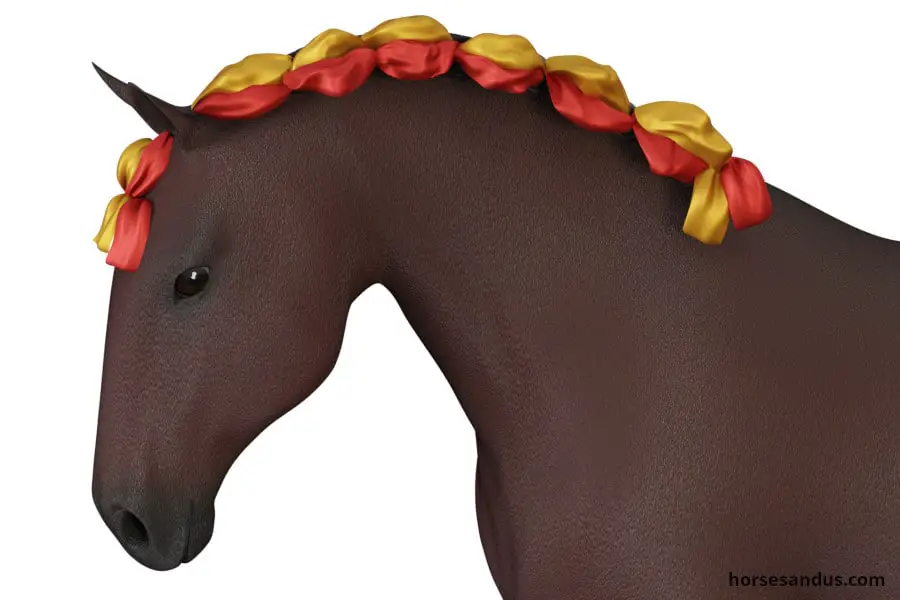
Some Lusitano horses from the Royal Alter Real stud farm are selected to enter the Portuguese School of Equestrian Art, where they are trained to perform some classical dressage exercises, along with exercises from the Baroque period such as “Airs above the Ground” and also exercises from the Court Games from the 16th and 19th centuries.
The Portuguese School of Equestrian Art then uses these highly trained horses to stage regular performances, which are a historical recreation of the 18th-century Portuguese court.
The riders are dressed in formal costumes of that period, and the horses are embellished with three-point Portuguese braids (Running Braid), decorated with silk ribbons.
Watch this video to learn more about this beautiful equestrian Art with these amazing horses.
Shire horse mane decoration
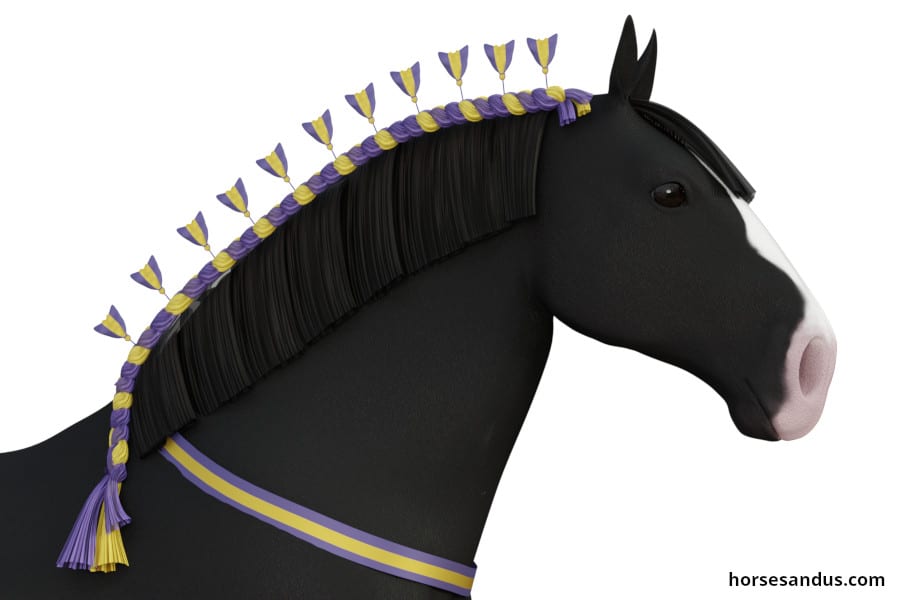
Different draft breeds have different rules for decorating the horse´s mane. In this article, we will only look at the Shire breed.
Shire horses are presented with very high standards when they participate in shows.
The traditional decorations put on the Shire horse´s mane are composed of:
- A Mane Roll, usually made from wool, is a three-strand braid interwoven with the mane at the top of the neck. Only the top portion of the mane is braided; the rest is left down.
- Mane Flights are used to accentuate the line of the horse´s neck. They are made with florist wire, which is braided into the mane roll. Usually, an odd number of flights, approximately 9 to 13, are put on the mane.
- A Neck Ribbon is tied around the base of the horse´s neck and secured to the mane at the withers. They can be single, double, or triple colored.
These decorations are placed on the horse´s mane so that the eye is drawn to the overall enhanced appearance of the horse´s neck.
Watch this video if you would like to learn how to do a traditional braid of the shire horse
Tangled Manes and Folk tales
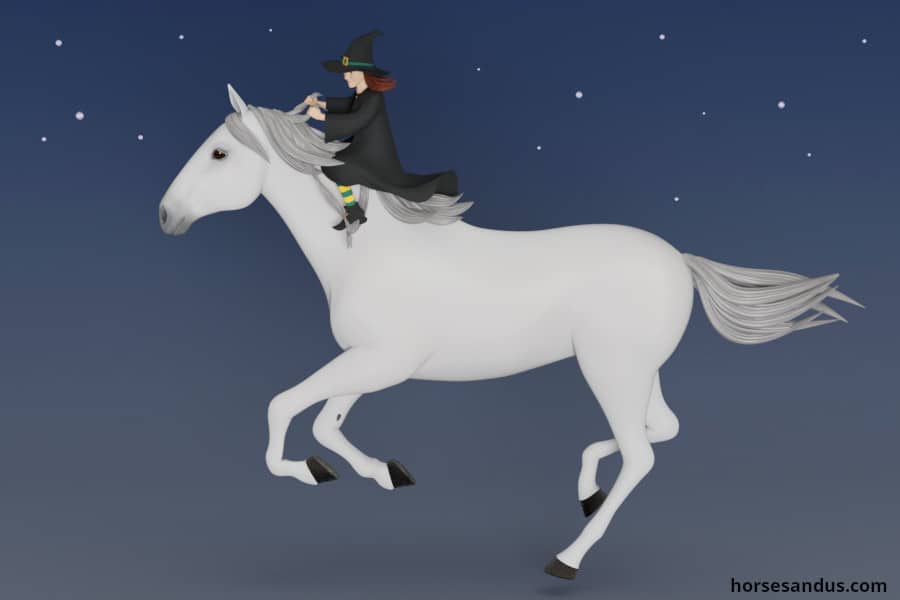
In European Folk Tales, the tangles in horses manes were attributed to Fairies, Elves, and Witches.
The folk tales mention that elves and fairies came at night to “braid” the horses’ mane into elf-locks or fairy-locks. These locks were so tangled that sometimes it was almost impossible to untangle them.
When two strands of hair were twisted together, the folk tales attributed this to witches. They would tangle the horse´s mane into stirrups to ride them at night.
These types of tangles are called witches stirrups or hag-knots.
